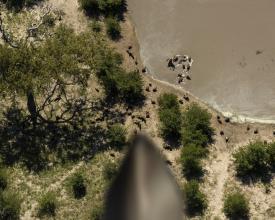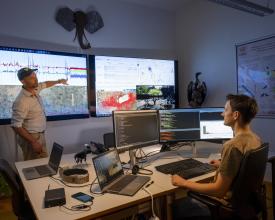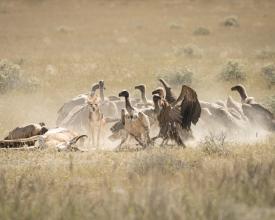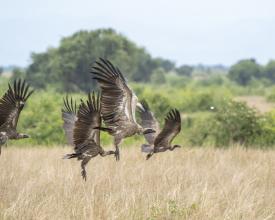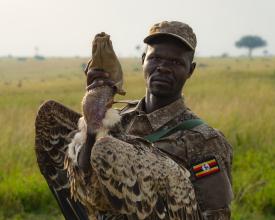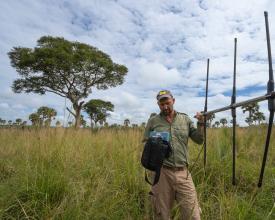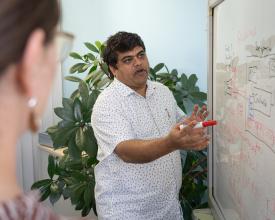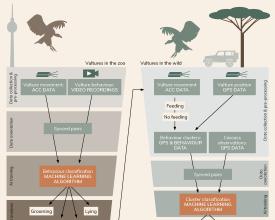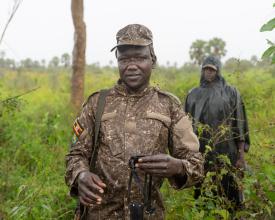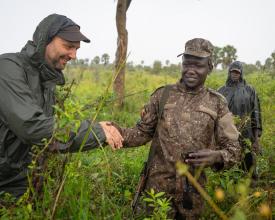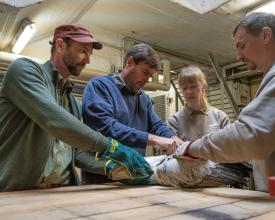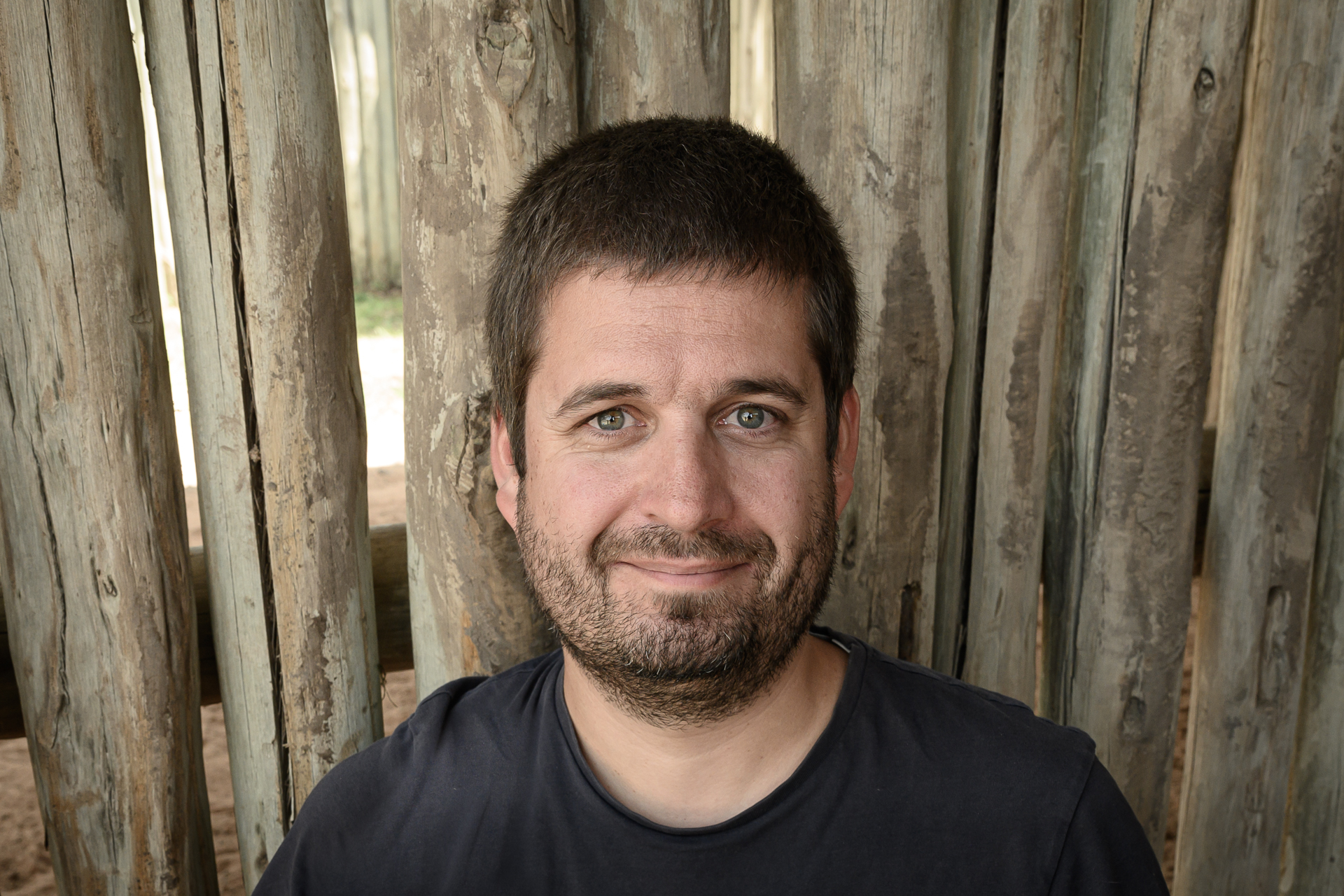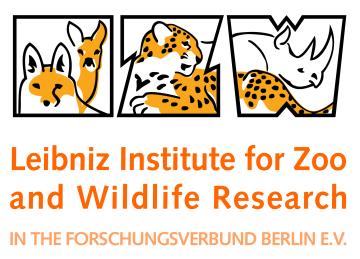
The GAIA i³ approach: Creating an AI-powered early-warning system for ecosystem disruptions
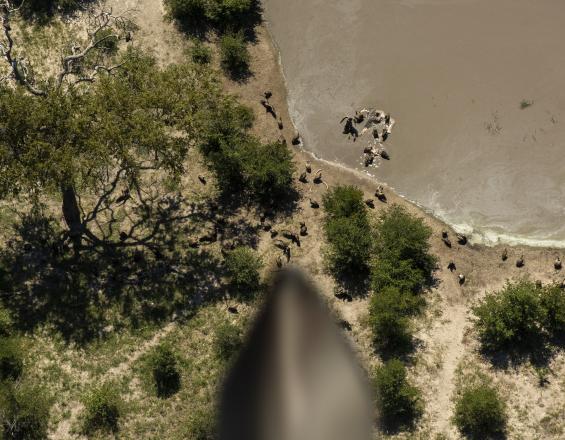
To effectively address the scale and speed of biodiversity loss, innovative approaches are needed that can deliver science-based insights for conservation faster and with more precision. The GAIA Initiative developed such an approach by combining the sensory abilities and intelligence of sentinel animals with human and artificial intelligence (AI) to create an early-warning system for environmental changes and critical incidents affecting ecosystems. Vultures, for example, can provide reliable and precise information on ecosystem disturbances, e.g. animal deaths caused by drought, disease, or human-wildlife conflict. With newly developed animal tags, AI pipelines, and IoT satellite infrastructures, GAIA harnesses this knowledge for conservation and detects threats in real-time to facilitate swift and adequate countermeasures. The GAIA approach is adaptable, scalable and applicable to diverse scenarios in different ecosystems worldwide to avert threats to species, ecosystems and humans.
Context
Challenges addressed
The GAIA solution provides critical knowledge to address several drivers of biodiversity loss. Many species face severe population declines and are vulnerable to wildlife disease outbreaks, prolonged droughts, human-wildlife conflicts and environmental crimes. Monitoring mortality incidents and rates among those species is imperative – particularly when mortality exceeds baseline levels. Two primary factors are crucial to effective interventions: to cover vast areas even in remote regions and to detect incidents with minimal delay. Addressing these challenges is the core of the GAIA i³ approach that integrates animal, artificial and human intelligence. Scavengers such as vultures achieve the coverage and speed through their highly evolved sensory capabilities and elaborate communication. The GAIA system that combines newly developed animal tags, AI-powered analysis pipelines and satellite communication allows to utilize these unique evolutionary adaptations in real-time.
Location
Process
Summary of the process
In order to tie the different working groups together and to create synergies with impact in environmental research and conservation, GAIA puts emphasis on bridging different disciplines and expertise. In the Initiative, biologists, veterinarians, AI experts and engineers collaborate with conservationists, politicians, entrepreneurs and various other stakeholders to create tools and knowledge that makes a difference. This implies the need of steep cross-sectoral learning curves: wildlife biologists learn how to develop and train artificial intelligence, engineers become knowledgeable in vulture anatomy and behaviour to design durable and practicable tag hardware, and scientific institutions work hand in hand with zoos to train AI and develop hardware in controlled settings. Last but not least, GAIA develops interfaces and tools for rangers, park staff, officers and other officials in the field to efficiently make use of the data and the knowledge.
Building Blocks
Understanding scavengers, predators, their communities, ecosystems and conservation challenges
Vultures are a highly intelligent group of birds that provide important ecosystem services. Yet, populations of old-world vultures decreased dramatically in the last decades owing to anthropogenic factors. Efficient conservation strategies that address critical threats such as indiscriminate poisoning or depleted food sources need to be developed. At the same time, their behaviour including social interactions is still poorly understood. Building on high-tech tracking equipment and AI-based analytical tools, GAIA aims at better understanding how vultures communicate, interact and cooperate, forage, breed and rear their young. Additionally, the GAIA scientists research the social foraging strategies of white-backed vultures and the information transfer within carnivore-scavenger-communities. In the animal kingdom it is common across taxa that the search for food is undertaken not only as individuals but in a group. Animals forage together or rely on knowledge from other individuals to find food. This so-called social foraging presumably yields benefits, for example concerning the amount of food that is found, the size of prey that can be hunted or the time required to access food. GAIA investigates species-specific mechanisms in behaviour and communication as well as the incentives, benefits and possible disadvantages for individuals.
By further understanding these intra- and inter-speficic connections and interactions, GAIA also contributes to better understanding roots of human-wildlife conflicts (which are often connected to carnivore behaviour) and to species management. In Namibia for example, research into the lion communities helps understanding their spatial behaviour and mitigating contacts with the local population (e.g. cattle farmers) to manage human-wildlife conflict (GBF target 4). This knowledge is also utilized to observe and manage local lion populations sustainably to benefit people (GBF target 9), balancing conflict mitigation and tourism.
Enabling factors
This building block is enabled by experience, funding and access: GAIA had the resources to hire excellent scientists with years of experience in investigating animal behaviour, spatial ecology, carnivore-scavenger interaction, intraspecific communication and human-wildlife conflicts. Additionally, GAIA stands on the shoulders of several decades of integration into science and stakeholder communities in wildlife management and conservation in southern Africa. This allowed access to protected/restricted areas with research permits to tag birds and collar carnivores for example.
Lesson learned
Newly published research results from the project (https://doi.org/10.1016/j.ecolmodel.2024.110941) confirm the benefits of cooperation and social information for foraging success. The results highlight social foraging strategies such as “chains of vultures” or “local enhancement” as overall more advantageous than the non-social strategy. The “chains of vultures” strategy outperformed “local enhancement” only in terms of searching efficiency under high vulture densities. Furthermore, the findings suggest that vultures in our study area likely adopt diverse foraging strategies influenced by variations in vulture and carcass density. The model developed in this study is potentially applicable beyond the specific study site, rendering it a versatile tool for investigating diverse species and environments.
Advancing animal-borne remote sensing, GPS tracking and monitoring
Satellites and aircrafts play a crucial role in gathering environmental data from the distance, helping us to better understand our climate and ecosystems. Remote sensing, often conducted from aircraft, balloons, or satellites, allows us to monitor large areas and remote regions over extended periods. These “eyes in the sky” are invaluable complements to land-based observations, helping us understand ocean and air currents, land cover changes, and climate change. However, animals also possess extraordinary senses and a unique ability to detect changes in their habitats. By combining animal capabilities with remote sensing technologies, GAIA aims at enhancing our ability to monitor and understand our planet. Animals have superior sensory abilities and behavioural strategies that enable them to sense subtle and dramatic changes in their ecosystems, as well as to detect critical incidents. Vultures, for example, act as “sentinel species” and can elevate the concept of remote sensing to new heights. They regularly patrol vast areas in search of food, operating without emissions, additional resources, or repairs. Furthermore, their patrols are guided by their exceptional vision and the mission to find carcasses. The way they patrol, what they search for, and the incidents they lead us to may be linked to specific environmental changes and ecological events.
To fully exploit the potential of vulture-borne remote sensing, GAIA focuses on two essential aspects. Firstly, powerful tracking devices are attached to vultures to monitor their movements and behaviour on detailed temporal and spatial scales. Secondly, new technological solutions are being developed to better understand what the animals observe and do. This includes a newly developed camera tag featuring an integrated camera, artificial intelligence algorithms for behaviour detection and image recognition, and satellite uplink for real-time coverage in remote regions. With these tools, animals can capture imagery and provide data of their surroundings faster, with higher resolution and specificity than satellite imagery. This innovative approach allows us to see nature through the eyes of animals.
GAIA has adopted a minimum waste strategy: Only technical equipment that is absolutely essential is used and developed. Collars and tags either remain for long periods of time (e.g. vultures) or are collected routinely (e.g. lions) to extract data. No transmitters remain in the landscape: If a transmitter drops of or the animal carrying the tag dies, it is located and removed from the landscape. This way, the GAIA system is a “leave no trace” system with significant benefits for the ecosystems.
Enabling factors
GAIA was able to deploy around 130 commercially available tags to vultures all across southern and East Africa. This relatively high number provided opportunity to study in great depth (both spatially and temporally) how the data from tagged sentinel species such as scavenging white-backed vultures can support ecosystem monitoring. Second, this building block is enabled by collaboration with, for example, Endangered Wildlife Trust, Kenya Bird of Prey Trust or Uganda Conservation Foundation.
Lesson learned
The GAIA studies have proven that the sensory capabilities and intelligence of sentinel species are indeed a great asset in ecosystem monitoring. Investigating vultures and ravens and analysing data from tags carried by these “eyes in the sky” have demonstrated they are highly superior to man and machine in localising carcasses in vast landscapes and can help monitoring mortality in ecosystems. And second, the GAIA studies confirmed that high-tech approaches are a means to connect to this valuable knowledge and utilize it for monitoring, research and conservation. Modern humans have notably disconnected from nature, failing to “read” and “listen to” nature. By means of innovative AI-powered tracking technology, not only animal-borne remote sensing for research and conservation is elevated, but also a connection to nature re-established.
Artificial intelligence(s) for behaviour recognition, carcass detection and image recognition
For ecological research as well as for GAIA use cases, it is necessary to reliably and accurately recognise the behaviour of different animal species over a long period of time in remote wilderness regions. To do this, GAIA scientists have developed and trained an artificial intelligence (AI) that can perform behavioural classification from GPS and acceleration data and tell us exactly what, for example, white-backed vultures fitted with animal tags are doing at any given time and place. This AI will eventually run directly on the GAIA animal tags and generate behavioural information from sensor data. In a second step, the scientists combined the behaviour thus classified with the GPS data from the tags. Using algorithms for spatial clustering, they identified locations where certain behaviours occurred more frequently. In this way, they obtained spatially and temporally finely resolved locations where vultures fed. Last but not least, GAIA is developing an AI for image recognition that will analyse photos taken by the integrated camera of the new tag system. All those algorithms will run directly on the tag and can perform efficient embedded data processing. This also places very special demands on image recognition AI, which must operate particularly sparingly and with small amounts of data. To this end, GAIA teams are developing appropriate strategies and models for sparse AI.
This novel carcass detection pipeline is a key asset in halting species extinction and managing human-wildlife conflicts and therefore aligns with GBF target 4. The pipeline allows for the swift detection of either vultures' death or the death of the animal that the vultures are feeding on. Both scenarious are relevant to halting species extinction: Poisoning at carcasses contributes significantly to the decline in populations of many vulture species. As vultures use social strategies in their search for food, one poisoned carcass can kill hundreds of birds. Scientists from the GAIA Initiative have shown that tagging vultures allows for an early detection of deaths and the carcass to be removed. Tagging vultures and using the AI pipelines described here can substantially reduce further mortalities. Secondly, early detection of poaching incidents of threatened species can put a local full stop to poaching and contribute significantly to combating extinction.
Enabling factors
This building block stands on the shoulders of two major enabling factors. First, the combination of expertise in wildlife biology and data analysis/artificial intelligence development in one staff member. It proved absolutely essential to have great experience in wildlife ecology and vulture behaviour in particular as well as the development of code and the training of algorithms of the AI. Second, the acquisition of a large set of training data – one of the key factors for a successful AI development – was only possible through the cooperation of a wildlife research institute and a zoological organisation. With vultures in captivity in a large aviary, both data collection with a tag and video recordings of relevant behaviour could be conducted. Only this allowed for synced pairs of reference data and a training of the AI algorithms.
Lesson learned
In this building block, GAIA achieved various tangible outcomes: First, the development of two integrated AI algorithms for vulture behaviour classification based on sensor data and for feeding cluster and carcass detection was completed and published in a peer-reviewed scientific journal (https://doi.org/10.1111/1365-2664.14810). The AI analysis pipeline has been running effectively for several years on sensor data from commercially available tags and provided many hundreds of potential carcass sites with a GPS location – an essential source of information for ranger patrols on the ground. Second, a similar AI pipeline has been developed for ravens. It is similarly efficient and can be utilized for mortality monitoring in North America or Europe, for example. Third, GAIA demonstrated that an extremely sparse image recognition AI can be trained to detect species from photos from the new tag camera. An fourth, a GAIA concept study showed that tags present at the same locality could form ad-hoc networks (digital swarms) within which AI calculations and other tasks such as joint backhauling can be shared.
Developing a new generation of animal tags and concepts for a digital swarm intelligence in networks of devices
To meet the goal of the GAIA Initiative to develop and put into practice a high-tech early-warning system for environmental changes, a new generation of animal tags is a key component. GAIA teams are working on the hardware and software development of miniaturized animal tags with lowest-power sensor technology with camera and image processing. The tags will be energy-autonomous, optimally adapted to the anatomy of vultures and are the basis for further technological features under development such as on-board artificial intelligences for behaviour detection and image recognition as well as a satellite-based IoT communication system.
Additionally, GAIA is developing concepts of distributed artificial intelligence and networks of micro-processors – animal tags that act just like a swarm. Analogous to natural swarm intelligence, the GAIA initiative is mapping digital swarm intelligence in an ad hoc network of microprocessors. These spontaneously forming networks are the foundation for distributed and sensor-based analysis of large amounts of data. Following this path will make it possible for vulture tags, for example, that are present at the same location during feeding events, to link and share tasks such as artificial intelligence analyses and data transmission.
Enabling factors
A key factor for the success of this building block is the interdisciplinary and cross-sectoral cooperation of the GAIA partners: The Leibniz-IZW provided biological and veterinary knowledge about vultures and provided goals for the technical design of the new tags. The Fraunhofer IIS provided expertise in energy-efficient hardware, electronics and mechanics as well as in software for the miniature units. The Zoo Berlin provided environment and access to animals to aid the design and test the prototypes at various stages. Partner organisations in Africa such as Uganda Conservation Foundation provided an environment for in-depth field tests of the tag prototypes.
Lesson learned
After several years of design and development, prototypes of the new tag system were tested in the wild in Uganda in November 2024. Wild white-backed vultures were equipped with prototypes called “data collection tag” (DCT) that featured many (albeit not all) innovations of the GAIA tag. The tags were released after 14 days from the vultures and collected using GPS and VHF signals, allowing for thorough examination of hardware and software performance as well as evaluation of collected data. These analyses will greatly help further developing the system.
Establishing a satellite-based IoT communication system
Relevant ecological processes and incidents that are of interest in environmental change research typically occur in remote areas beyond the reach of terrestrial communication infrastructures. Data generated in the field using animal tags in these regions can often only be transmitted with a delay of days or even weeks. To overcome this delay and ensure no delay in the early-warning system, GAIA develops a satellite communication module for the tags as well as a nanosatellite operating in low earth orbit (LEO): In order to be able to transmit collected data and information directly from the transmitting node to the LEO satellite (Low Earth Orbit), a high-performance satellite IoT radio module will be integrated into the new tags. This guarantees immediate, secure and energy-efficient transmission of the extracted data. The communication system is based on the terrestrial mioty® technology and will be adapted to satellite-typical frequency bands such as L- and S-band for the project. Typical communication protocols, which are sometimes used in the IoT sector, are usually designed for small packet sizes. Further development of the mioty® system will therefore also aim to increase the data rate and message size to enable application scenarios such as image transmissions.
The satellite IoT system will be key for a no-delay communication and thus for an early-warning system. It greatly contributes to the GAIA system in achieving GBF target 4 "Halt Extinction, Protect Genetic Diversity and Manage Human-Wildlife Conflicts".
Enabling factors
A significant share of the GAIA research and development was funded by the German Space Agency (DLR). This provided not only budgets for the development of the mioty® communication modules in the tags and first modules and concepts of the nanosatellites, but also access to an ecosystem of space-tech stakeholders. The start-up Rapidcubes became a key partner in the Initiative for the satellite development and plans for subsequent project phases include collaboration with existing DLR infrastructure such as the Heinrich Hertz satellite.
Lesson learned
The adaptation of the terrestrial mioty® protocols for satellite communication were successful. With the Ariane 6, an experimental nanosatellite was launched into a low earth orbit in July 2024. Since then, communication protocols are tested and refined for future application for the GAIA early-warning system.
Integrating zoological gardens and animals under human care into a science- and technology-driven research and conservation project
Modern Zoological gardens and aquariums worldwide provide unique opportunities by contributing expertise in animal care, species conservation, and public education, forming a strong foundation for modern conservation and scientific research. By working closely with these institutions and utilizing the data and insights they generate, the GAIA Initiative aims at bridging the gap between in-situ and ex-situ conservation efforts. Animals under human care can serve as valuable models for understanding species’ biology, behaviour, and responses to environmental changes. Furthermore, the controlled conditions of zoological gardens allow for the development and testing of advanced technologies, such as animal-borne sensors and AI systems, under more predictable and accessible settings before deployment in the wild.
Key focus areas of this building block include:
- Generating reference and training data for the development of the AI pipeline for the sensor data. By deploying the tags on vultures in captivity in a large aviary and recoding their behaviour simultaneously, we were able to create a paired dataset for the training of the AI. With the trained AI there is no more need to observe the animals to detect relevant behaviour, e.g. feeding; the AI can very reliably predict behaviour from the sensor data giving us insights in the behaviour of the target animals throughout their life.
- Education and public engagement: Zoo Berlin integrates GAIA’s findings into its educational programs and collaborates in media relations and public outreach, fostering public awareness and participation in biodiversity conservation and technological innovations. Visitors are introduced to cutting-edge tools and their impact on wildlife conservation.
Having minimal and only strictly necessary impact on individual animals is a key goal of the GAIA Initiative. For both lions and vultures, there were extensive testing procedures conducted (within the German system of Animal Testing and Animal Welfare) in Berlin Zoo and Berlin Tierpark. Techniques were developed and tested by veterinary experts for both zoo animals and wildlife and are considered safe and compatible with strict animal welfare considerations. Additionally, both within GAIA and by other research groups there is long-term experience and data on the effects of tagging and collaring of the respective species. It has been proven, for example, that tagging vultures does not have any detrimental effects on the birds’ well-being, health or reproduction. Vulture were found to live many years with tags, to have similar movement and foraging behavior, and to have offspring.
The partnership of GAIA with the Zoo Berlin also emphasises the communication and knowledge transfer objectives of the Initiative in the sense of the GBF target 21 "Ensure that Knowledge is Available and Accessible to Guide Biodiversity Action". This field of activitey not only targets the wider public for raising awareness for biodiversity conservation and technological innovations, but also aims at political decision makers on national and international levels. GAIA has been very active in consulting with political stakeholders in Germany and Namibia for example as well as participating in the IUCN Regional Conservation Forum 2024 in Bruges, Belgium.
Local capacity building for implementing and upscaling the solution
The GAIA Initiative conducts important capacity building measures as the developed early-warning system is put into practice together with local parks and authorities in many African countries such as Namibia, Mozambique and Uganda. Park staff, officers in relevant authorities and in ministries are trained while implementing the system. This includes empowering local communities to conduct collaring, tagging, and tracking with the GAIA system as well as implementing the early-warning pipeline using the designated frontend.
Additionally, GAIA staff is actively educating students in various disciplines and research fields to support novel technologies for conservation and life scienes. In the past 6 years more than 250 students successfully partipated in courses conducted by GAIA staff at the University of Namibia in veterinary science and wildlife biology with special focus on, for example, human-wildlife conflict, animal tracking as well as vulture, lion and hyena behaviour.
Both professional capacity building and student training directly targets local communities to enable them to run the GAIA early-warning system largely with local knowledge and resources alone. This building block puts the GBF target 20 "Strengthen Capacity Building, Technology Transfer, and Scientific and Technical Cooperation for Biodiversity" at the core of the GAIA Initiative as this block is not an addendum to the research and development part of the Inititiative, but a key field of action from the very beginning.
Enabling factors
Capacity building and university training rely on long-term relationships and embeddedness of the GAIA staff in the respective local communities and organisations. Especially in Namibia, there has been a 25-year track record of collaborating with the relevant bodies that GAIA is now able to utilize for capacity building and education. Furthermore, an investment in technology transfer and support is needed to enable local partners to adopt and implement the system.
Lesson learned
Effective implementation of a novel approach is a challenging task, especially on the long run. GAIA integrated the implementation perspective from the very beginning, but still needed to put more emphasis in establishing routines, processes and responsibilities together with the authorities involved. Under the GAIA umbrella, the scientist started a designated three-year project funded by the German Ministry for the Environment, Nature Conservation, Nuclear Safety and Consumer Protection. This project will push local capacity building and implementation and secure a sustainable roll-out .
Impacts
The GAIA i³ early-warning system is operating since May 2022 when the first white-backed vultures were equipped with tags. Since then, more than 130 vultures all across Africa were tagged, delivering data from 13 African countries. They patrolled over 7 million kilometres and collected more than 100 million GPS data points. GAIA derived valuable information from this data, e.g. on vulture behaviour and ecosystem health, and detected critical incidents in several hundred cases. These included cases of poisoning, mostly targeting carnivores as a result of human-wildlife conflict, cases of wildlife diseases such as anthrax and cases of illegal killing of wildlife for bushmeat, ivory or rhino horn. GAIA works hand in hand with governments and authorities, facilitating targeted patrols and supporting law enforcement, in several countries. This collaboration yielded 100+ detected cases of rhino poaching alone, interrupting poaching campaigns in remote regions, preventing further killing of animals and leading to arrests of involved persons.
Additionally, GAIA raises awareness for scavengers and their valuable ecosystem services through outreach and environmental education. Orchestrated efforts in strategic communication yielded political support in Germany in different ministries and governmental organisations, building the base for continuous operation and extension of the GAIA i³ early-warning system.
Beneficiaries
- Scientists in wildlife biology, veterinary sciences, wildlife management or conservation
- Conservation and wildlife management organisations and staff
- Authorities in environmental crimes, public health, livestock and food safety
- and many more …
Additionally, explain the scalability potential of your Solution. Can it be replicated or expanded to other regions or ecosystem?
The GAIA i³ approach provides a solution for ecosystem monitoring and research – and thereby for species conservation – applicable to a variety of scenarios and ecosystems worldwide. It allows to quickly and reliable detect animal mortality through a combination of (scavenging) sentinel animals and high-tech equipment and processes. In its pilot phase the solution focused on scavenger communities in savannah ecosystems in Southern and East Africa. In subsequent phases, the GAIA approach will be transferred to other ecosystems, e.g. to temperate forests in central Europe to monitor African swine fever outbreaks in wild boars with the help of ravens – relevant AI-powered analysis pipelines have already been established for this use case – or to the ocean to detect illegal fishing with tagged albatrosses.
Global Biodiversity Framework (GBF)
Sustainable Development Goals
Story
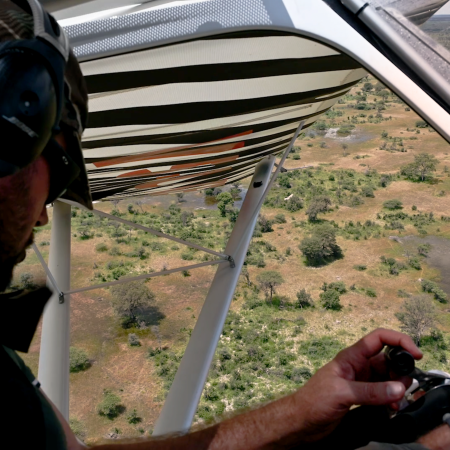
The year 2012 marked a peak in elephant poaching in the Zambezi Region in Namibia at the border to Angola, Zambia, Botswana, and Zimbabwe. I was part of a team that was trying to monitor the situation, find carcasses and maybe keep the dramatic situation at bay. One day we were notified that another elephant carcass was located and there also was a mention of vultures at the carcass. I flew my small fixed-wing to the spot and was shocked to see not only a few vultures, but dozens, if not hundreds – and they were all dead. I returned and we drove to the scene of the crime. And a crime scene it was, it was hard to watch: the elephant was killed and poisoned afterwards so that the vultures would not reveal its location.
We spent the next hours counting the vultures, piling them up in large heaps and burning the remains to remove the poison from the ecosystem and the food chain. There were more than 400 of them at this single carcass. Vultures were already in steep decline back then and we knew we also had to keep an eye at the scavengers or we would lose them faster than the elephants. There, the idea was born to equip them with tags to learn more about their movement, their behaviour and their role in ecosystems. We also hoped to detect poisoning incidents very fast to remove the toxins before other vultures die. We only had two tags but quickly realized that even with these limited resources we were finding dead elephants much faster than before. Within three months we found more than 150 killed elephants, just by looking at the GPS coordinates of the vulture tags and flying to spots where they spend a lot of time. It was mind-blowing and eye-opening to see the potential of the knowledge of animals helping research and conservation.
Over the next years, the idea developed into a concept and then into a project. We realized we needed more sophisticated tools and processes to “hack” into the animal world. Spots where vultures spend time are just a mediocre proxy for carcass locations – AI-powered analyses of position and movement data could really unlock their secret knowledge. If the tag itself ran these algorithms, carcass locations would be derived live and on-site – combined with satellite link to send this information from wherever in the wild, we envisioned a powerful high-tech early-warning system for acute threats to animals and ecosystems. Now that we are here, it feels almost unreal. It all started with 400 dead vultures at an elephant carcass.
GAIA project head Ortwin Aschenborn


